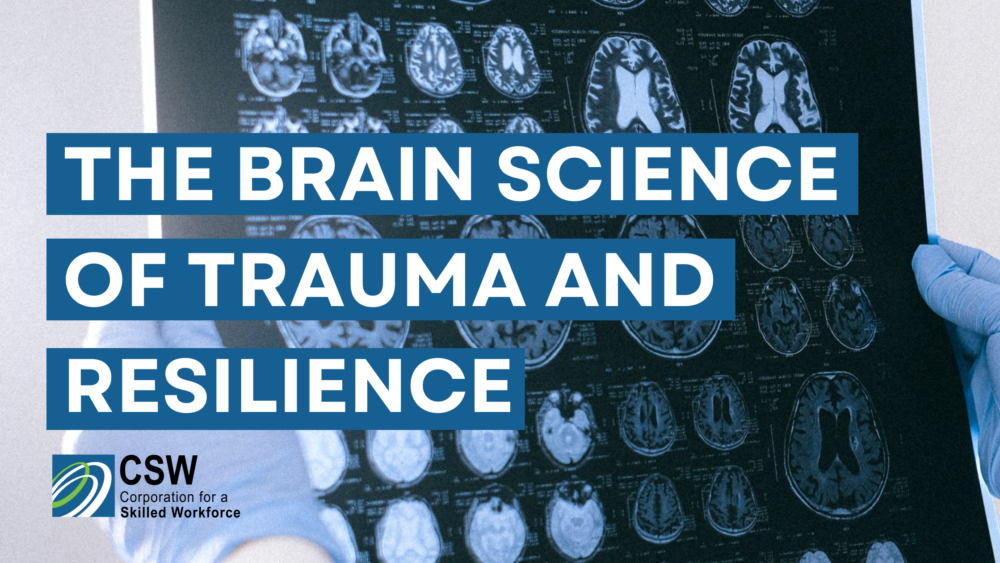Lucia is a career consultant at a workforce development career center in a large, diverse city in the Upper Great Lakes region. Prior to the COVID-19 pandemic, she was excelling at her job. She was engaged, clients loved her, and her supervisor was impressed with her potential. However, once the pandemic hit, she started to struggle. She could not keep up with requests to help clients or respond to coworkers. She would go days without answering emails. Small mistakes would devastate her and consume her for the rest of the day. When faced with new or complex tasks, she would completely freeze, and mentally check out. Coworkers would often wonder, “Why is she not even trying?” After a meeting one day, Lucia opened up to a trusted coworker, Marcus, and said that she was not doing emotionally well and asked for help.
This is a true story.
Has this happened to you? Have you been in Lucia’s shoes? Have you been in Marcus’ shoes? Has a colleague or workforce development customer exhibited behaviors that are not typical for them, and you are concerned about?
Although she did not consciously realize it, Lucia had undergone significant emotional trauma that changed her brain’s response to stressors. The horror and uncertainty of the pandemic was overwhelming for her. Several family members died from the virus. She struggled with the stress of suddenly working from home and having to figure out how to remotely serve stressed-out workforce development clients, many of whom were unemployed, without financial resources, had rickety digital technology, and had limited capacity to engage in anything beyond survival.
On top of this, the resurging racial injustice such as the murders of Ahmaud Arbery, George Floyd, and Breonna Taylor made Lucia angry and depressed. The challenges that Lucia was experiencing at work were normal brain reactions to abnormal situations. Our brains subconsciously react with fight, flight, freeze, or submit responses to toxic stress and trauma, often resulting in behaviors that confuse us and others. An overwhelming level of stress and trauma can lead to mental health conditions that undermine our success in work and life.
Mental health conditions are more prevalent than you might initially think. In a survey among working adults, it was reported that 76 percent of employees have struggled with at least one issue affecting their mental health, only 42 percent have been diagnosed, and only 37 percent have disclosed this diagnosis to their employer (https://ceoroundtable.heart.org/mentalhealth/executive-summary/highlighted-findings/).
This means that seven to eight out of ten people in your office or organization have struggled with a mental health condition at some point. Toxic stress and trauma often are the root cause of mental health challenges.
The COVID-19 pandemic has exacerbated these numbers. Nationally, two out of five adults report symptoms of anxiety or depression, the two most common mental health conditions, with the national prevalence of anxiety and depression increasing by 25% in the first year of the COVID-19 pandemic (https://www.kff.org/report-section/the-implications-of-covid-19-for-mental-health-and-substance-use-issue-brief/). The toxic stress and trauma of the pandemic, racial reckoning, mass shootings, and climate change are predominant sources of growing anxiety and depression.
The pandemic and uncertainty are not over, and trauma has a long tail, so workforce development staff and clients are still struggling with symptoms of toxic stress and trauma, like so many others in our society. This has led to high levels of burnout and turnover and reduced engagement and quality of services for workforce development customers.
How does this affect you and what can you do about it? Inform yourself and colleagues. Talk with your employer about organization-wide training and organizational coaching to cultivate a more trauma-informed and resilience-building workplace.
Workforce development staff are not mental health professionals, nor should we attempt to play that role. But there are so many practices and strategies we can adopt on a daily basis that don’t require us to be mental health professionals or take a lot of time or money to be more trauma-informed and resilience-building.
Corporation for a Skilled Workforce (CSW) is a national organization that focuses on increasing economic opportunity and racial equity in communities across the country. Our Trauma and Resilience at Work team advances workplaces and workforces that are culturally responsive, trauma-informed, resilience-building, and supportive of mental well-being. CSW has just come out with a practical series of “quick guides” to help workforce development leaders and practitioners understand the neuroscience behind trauma and resilience and get actionable steps to mitigate and manage toxic stress and trauma and to cultivate a culture of resiliency in our organizations. We’ve designed this four-part series as a tool you can use and refer back to as you engage in your day-to-day work:
Today, we are sharing the first one that briefly explains the brain science of trauma and resilience. We believe it is important to understand the neuroscience basics to understand how to respond in healing ways to toxic stress and trauma behaviors—as exhibited by our customers, colleagues, and ourselves. You will find that much of this is intuitive or easy to grasp. You’ll be able to start seeing people and situations through a “trauma lens.” Next week, we will release the second in the series, which outlines how toxic stress and trauma show up in workforce development programs, services, and clients. You likely will recognize the trauma signs and symptoms but will see them in a different light with your new trauma lenses and will understand how to respond in healthy ways to mitigate and manage the trauma symptoms and help build resilience.



Comments are closed.